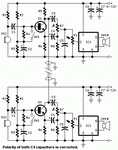elecfan
Member level 1
Dear all
I am working on a 2-way analog intercom,
I need a suitable 2-channel pre-amplifier with AGC.
I am trying to use a half duplex communication, with channel priority,
in order to avoid laud noise of the speaker
your help will be appreciated
Best regards
I am working on a 2-way analog intercom,
I need a suitable 2-channel pre-amplifier with AGC.
I am trying to use a half duplex communication, with channel priority,
in order to avoid laud noise of the speaker
your help will be appreciated
Best regards

